Governing body AFL NSW/ACT Registered players Unknown | First played 1911, Canberra | |
 | ||
Representative team Australian Capital Territory Single match 14,922 (4 June 2006), AFL Kangaroos v Sydney Swans (Manuka Oval, Canberra) | ||
Australian rules football in the Australian Capital Territory has a history dating back to the formation of the territory in the 1910s.
Contents
- History
- Great ACT footballers
- Notable ACT players in the AFL
- Governing body
- Open
- Masters
- Womens
- Representative Side
- Principal venues
- Attendance record
- Major Australian rules events in the ACT
- References
Traditionally, Canberra was considered to be one of the points which define the Barassi Line; however, the popularity of Australian rules football suffered substantially when teams from the national competitions were introduced in both rugby union and rugby league.
Despite Canberra not having a locally based team in the Australian Football League (AFL), the AFL does schedule regular matches in the city. It remains a popular sport and as well as a strong local competition, national competition games are played there by neutral AFL sides. From 2012, Greater Western Sydney acts as a local side, playing four home games a year at Manuka Oval.
History
1911 saw the first recorded match of Australian rules in Canberra between the Royal Military College and employees of the Home Affairs Department.
Three teams (Canberra, Duntroon and Federals) contested matches at the Acton Racecourse (now covered by Lake Burley Griffin) and at Blanfordia (now Manuka Oval).
In 1924, the first regular league was formed in the ACT, named the Federal Territory Australian Rules Football League.
New clubs gradually entered the league, when in 1927 it became known as the Canberra Australian National Football League (CANFL).
In 1931, the Canberra Australian National Junior League was formed.
Gate takings increased by 40% in 1975, and the CANFL changed to ACTAFL.
Australian rules football was a very popular sport in the territory until the expansion of the then-Australian Rugby League club competition, to incorporate a local team, the Canberra Raiders, in 1982. The team was highly successful and effectively made rugby league the most popular sport in the territory.
In 1990, the AFL scheduled an International Rules match for Canberra Stadium, which saw an attendance of 7,000.
The introduction of a successful locally based rugby union side, the ACT Brumbies in 1996 (and a slide in Raiders on-field performance), saw rugby union overtake rugby league as the most popular sport. Some believe that a successful local team in the national competition would re-establish Australian rules as a popular sport; however, the small population is not seen as generating sustainable high crowds and sponsorship required for an AFL team.
The Fitzroy Football Club expressed interest to the AFL in playing home games in Canberra. Accordingly, the AFL scheduled the first match to be played in Canberra for Round 9, 1995 match between the Fitzroy and the West Coast Eagles. Like the earlier International Rules, the match was played at the rectangular Bruce Stadium rather than Manuka Oval. Despite a frost, the match attracted a large amount of interest and a crowd of just under 12,000 attended and the Eagles defeated the struggling Lions by 28 points.
In 1998, the AFL (NSW/ACT) Commission took over operations of the ACTAFL.
Since 1998, Canberra has hosted the Barassi International Australian Football Youth Tournament.
In 2001, the AFL club the Kangaroos signed a deal with the ACT government to play some home matches at Manuka Oval. The team has drawn crowds averaging around 10,000 at Manuka Oval. However, in 2007 the Kangaroos received a more lucrative offer, to play some home games at Carrara Stadium on the Gold Coast, Queensland, and signed a deal to that effect. In August 2006, the AFL announced that the Melbourne Demons and Western Bulldogs would each play home games at Manuka, to fill the void left by the Kangaroos.
Great ACT footballers
Over the years, the ACT has produced many top players for elite professional leagues such as the Australian Football League, including Alex Jesaulenko, Adrian Barich, Shaun Smith, Craig Bolton, Brett Allison, James Hird and Aaron Hamill.
Notable ACT players in the AFL
Jason Tutt (Western Bulldogs) was recruited from the Ainslie Football Club. Josh Bruce (GWS) was recruited from the Eastlake Football Club. Phil Davis (GWS) was recruited from Marist Brothers ACT.
Governing body
The governing body is AFL NSW/ACT.
Open
Masters
Women's
Representative Side
An Australian Capital Territory representative side played Interstate Football matches against other states and territories. The Australian Capital Territory's first National Football Carnival appearance was at the 1933 National Football Carnival. The side placed second in Division 2 of the 1958 National Football Carnival, and second in the 1968 Minor States National Football Carnival. In the 1990s, the ACT team was merged with the New South Wales team to form NSW/ACT; and from 1995, the ACT was represented in interstate football as part of The Allies team, which also incorporated players from New South Wales, Queensland, Northern Territory and Tasmania.
